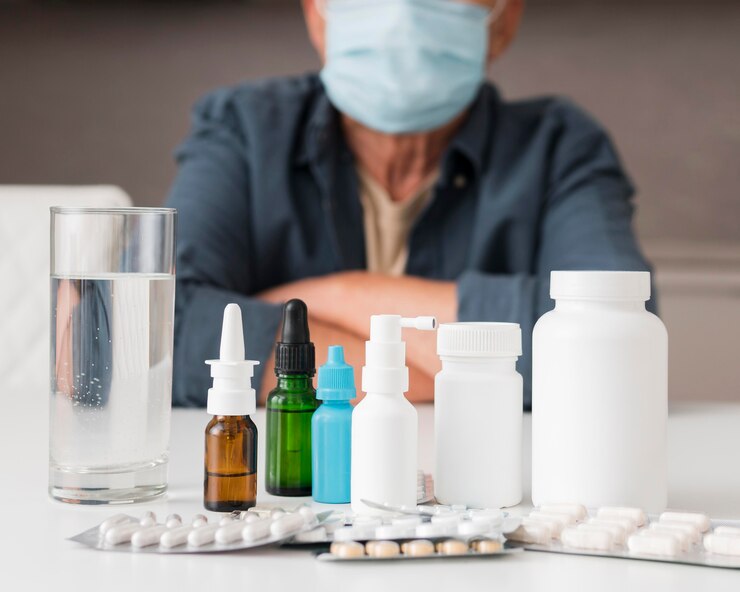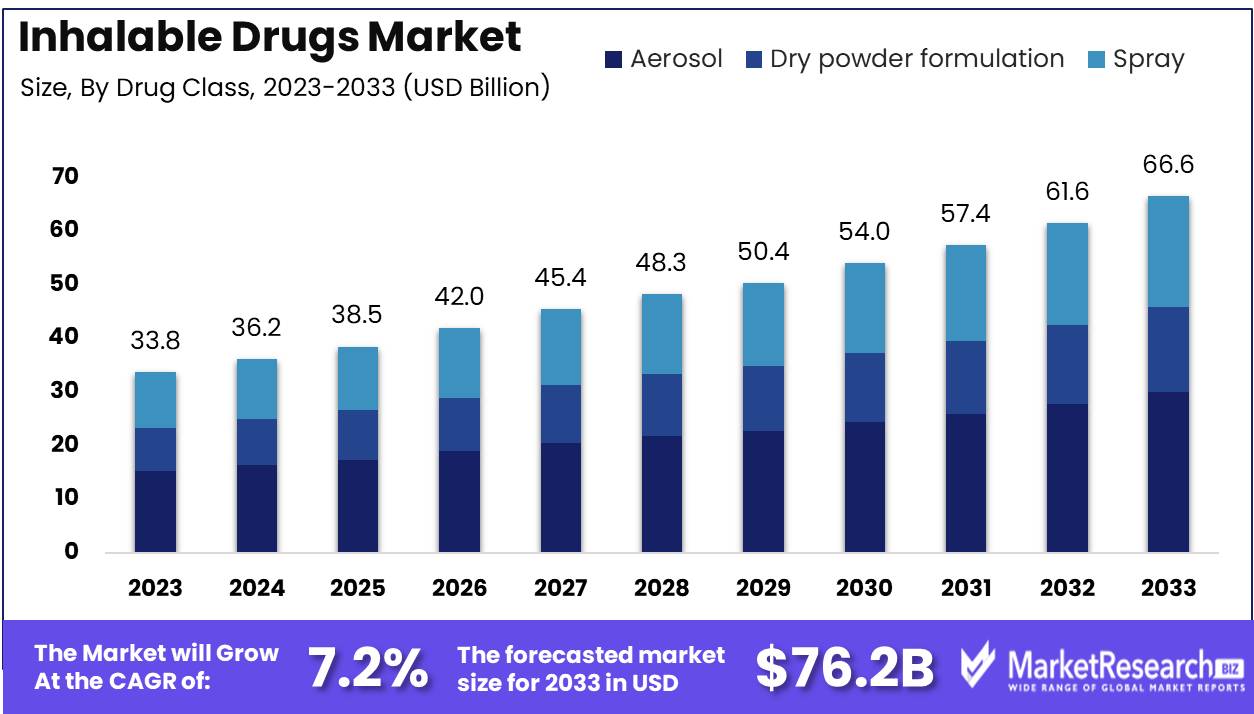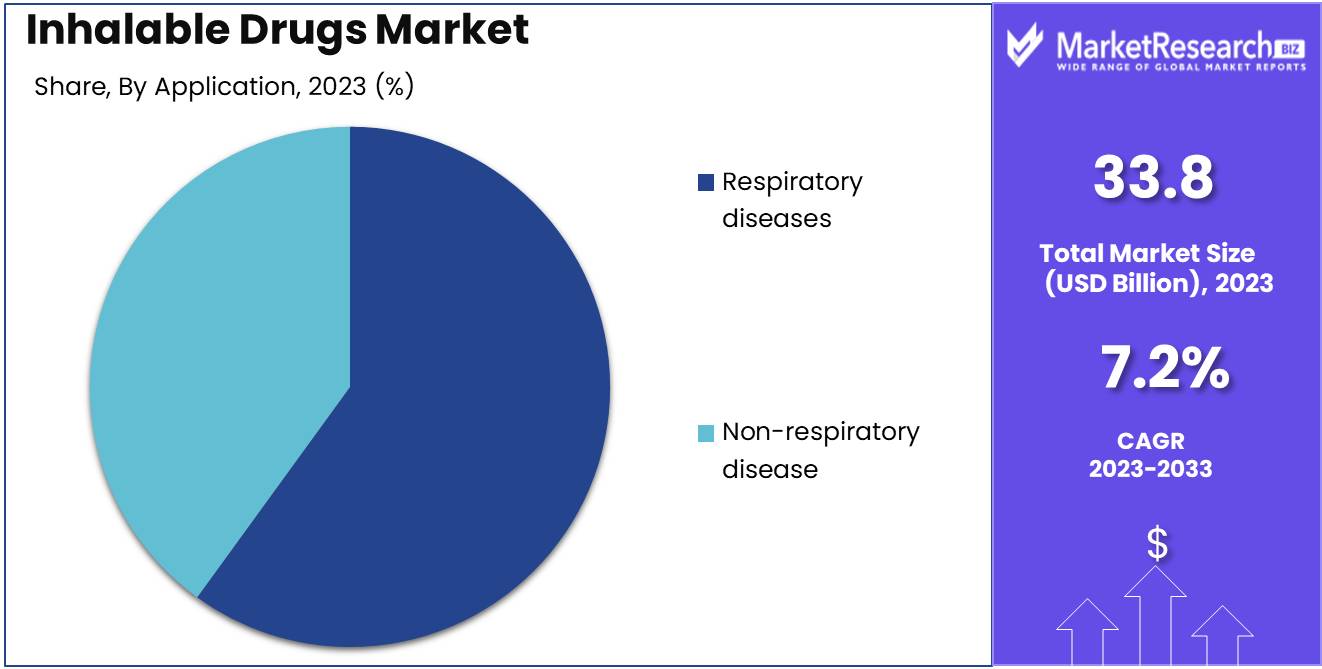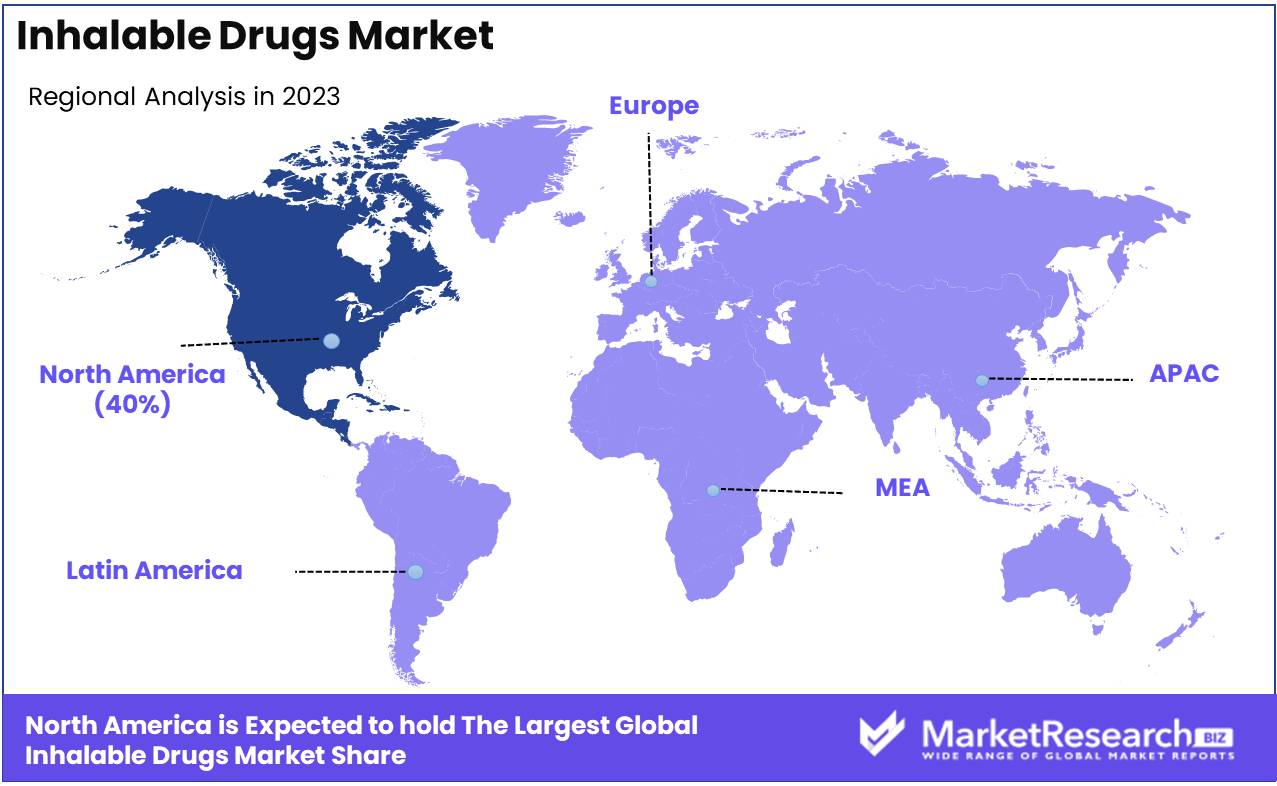
Inhalable Drugs Market By Drug Class (Aerosol, Dry powder formulation, Spray), By Application (Respiratory diseases, Non-respiratory disease), By Region and Companies - Industry Segment Outlook, Market Assessment, Competition Scenario, Trends and Forecast 2024-2033
-
45240
-
April 2024
-
241
-
-
This report was compiled by Trishita Deb Trishita Deb is an experienced market research and consulting professional with over 7 years of expertise across healthcare, consumer goods, and materials, contributing to over 400 healthcare-related reports. Correspondence Team Lead- Healthcare Linkedin | Detailed Market research Methodology Our methodology involves a mix of primary research, including interviews with leading mental health experts, and secondary research from reputable medical journals and databases. View Detailed Methodology Page
-
Quick Navigation
Report Overview
The Global Inhalable Drugs Market was valued at USD 33.8 Bn in 2023. It is expected to reach USD 76.2 Bn by 2033, with a CAGR of 7.2% during the forecast period from 2024 to 2033.
The Inhalable Drugs Market refers to the dynamic sector within the pharmaceutical industry focused on the development, production, and distribution of medications delivered via inhalation. Leveraging advanced technologies such as dry powder inhalers, metered-dose inhalers, and nebulizers, this market caters to diverse therapeutic areas, including respiratory diseases, diabetes, and pain management. With a growing demand for non-invasive drug delivery methods and the advent of innovative formulations, the Inhalable Drugs Market presents lucrative opportunities for pharmaceutical companies to enhance patient experience, improve treatment outcomes, and gain a competitive edge in the global healthcare landscape.

The Inhalable Drugs Market continues to witness steady growth, driven by increasing prevalence of respiratory diseases, advancements in drug delivery technologies, and rising adoption of inhalable drugs for convenient and effective treatment. Inhalable drugs offer several advantages such as rapid onset of action, targeted delivery to the respiratory system, and reduced systemic side effects, making them a preferred choice for patients and healthcare providers alike.
Inhalable drugs have gained significant traction in the pharmaceutical industry, with a diverse range of products available for the treatment of conditions including asthma, chronic obstructive pulmonary disease (COPD), and cystic fibrosis. The market is further bolstered by the introduction of innovative inhalation devices and formulations, enhancing patient compliance and therapeutic outcomes.
Supportive data underscores the substantial scope of inhalant use in the United States, with approximately 0.8% of individuals aged 12 or older reporting inhalant use in the past 12 months in 2021. Particularly concerning is the prevalence among students, as evidenced by 3.6% of 8th graders, 2.4% of 10th graders, and 1.8% of 12th graders reporting inhalant use in the past year (2022). Such statistics not only highlight the widespread utilization of inhalants but also emphasize the importance of regulatory measures and public health interventions to mitigate associated risks.
From this analysis include the growing demand for inhalable drugs, fueled by demographic trends, technological advancements, and evolving treatment paradigms. Market players should capitalize on these opportunities by investing in research and development, expanding product portfolios, and forging strategic partnerships to address unmet medical needs and capture a larger share of the inhalable drugs market.
Key Takeaways
- Market Value: The Global Inhalable Drugs Market was valued at USD 33.8 Bn in 2023. It is expected to reach USD 76.2 Bn by 2033, with a CAGR of 7.2% during the forecast period from 2024 to 2033.
- By Drug Class: Aerosol formulations dominate the market with a share of 45%.
- By Application: Inhalable drugs primarily target respiratory diseases, capturing a substantial 60% share.
- Regional Dominance: North America leads the inhalable drugs market with a 40% share, propelled by advanced healthcare and high respiratory disease rates.
- Growth Opportunities: The innovation and development of inhalable drug formulations, particularly in expanding applications beyond respiratory diseases and enhancing delivery efficiency to meet diverse medical needs.
Driving factors
Rising Incidence of Respiratory Diseases and Non-Respiratory Conditions
The increasing prevalence of respiratory diseases, such as asthma, chronic obstructive pulmonary disease (COPD), and cystic fibrosis, is a significant driving force behind the growth of the inhalable drugs market. According to the World Health Organization (WHO), respiratory diseases are responsible for millions of deaths worldwide each year. Additionally, the prevalence of non-respiratory conditions, like diabetes and cardiovascular diseases, which can also benefit from inhalable drug delivery systems, further expands the market's potential.
As these conditions become more prevalent due to factors like aging populations and environmental pollution, the demand for effective inhalable drug treatments rises correspondingly.
Increasing Geriatric Population
The global population is aging rapidly, with the number of elderly individuals expected to double by 2050. The elderly are particularly susceptible to respiratory diseases and other chronic conditions that often require long-term medication. Inhalable drugs offer several advantages for this demographic, including ease of administration and reduced systemic side effects.
As the geriatric population grows, so does the demand for inhalable drugs, creating a substantial market opportunity for pharmaceutical companies.
Advancement in Inhalable Drugs
Advancements in inhalable drug delivery technology have revolutionized the treatment landscape for respiratory and non-respiratory conditions alike. Innovations such as dry powder inhalers (DPIs), metered-dose inhalers (MDIs), and nebulizers have improved drug efficacy, patient compliance, and convenience. Furthermore, the development of novel formulations and drug combinations has expanded the therapeutic options available through inhalable delivery.
These advancements not only enhance patient outcomes but also drive market growth by attracting investment, fostering competition, and expanding the addressable patient population.
Strong Presence of Leading Players in the Market
The presence of established pharmaceutical companies with expertise in inhalable drug development and manufacturing strengthens the market's foundation. These leading players possess the resources, research capabilities, and market reach to drive innovation, develop new products, and penetrate global markets effectively. Moreover, their strong brand recognition and distribution networks facilitate the adoption of inhalable drugs among healthcare professionals and patients. As these companies continue to invest in research and development, strategic partnerships, and marketing efforts, they further propel market expansion, solidifying their dominance and stimulating overall growth.
Restraining Factors
Overcoming Compatibility Hurdles in Inhalable Drugs
Achieving compatibility between medications and inhalable delivery systems is paramount for market expansion. This challenge arises from the diverse chemical properties of drugs, necessitating specialized formulations for effective inhalation. However, advancements in drug formulation technologies, such as particle engineering and nanotechnology, are enabling the development of inhalable formulations for a broader range of medications. Pharmaceutical companies are investing heavily in research to overcome these hurdles, resulting in the introduction of new inhalable drugs to the market.
Collaborations between drug manufacturers and inhaler device developers are streamlining the process of creating compatible drug-device combinations. By addressing compatibility issues, the industry enhances patient convenience, improves treatment efficacy, and expands the addressable market for inhalable drugs.
Insurance Coverage Constraints
While the demand for inhalable drugs is on the rise, limited insurance coverage poses a significant barrier to market growth. Insufficient reimbursement and restricted coverage for certain inhalable medications deter patients from accessing these treatments, thereby limiting market penetration. However, collaborations between pharmaceutical companies and insurance providers are increasingly common, aiming to improve coverage and reimbursement policies for inhalable drugs.
As more clinical data becomes available demonstrating the efficacy and cost-effectiveness of inhalable treatments, insurers are likely to expand coverage for these medications. Enhanced insurance coverage not only increases patient access but also incentivizes pharmaceutical companies to invest in the development of inhalable drugs, driving further market growth.
Converting Pharmaceuticals to Inhalable Formulations
The conversion of active pharmaceutical ingredient into inhalable formulations is a complex process that requires overcoming various scientific and technical challenges. However, advancements in formulation science and manufacturing technologies are facilitating this conversion process. Pharmaceutical companies are leveraging techniques such as spray drying, micronization and liposomal encapsulation to develop inhalable formulations of existing drugs. Collaborations between pharmaceutical companies and research institutions are accelerating the pace of innovation in inhalable drug development.
By converting a broader range of pharmaceuticals into inhalable formulations, the industry expands the portfolio of available inhalable drugs, catering to a wider range of medical conditions. This diversification not only increases market potential but also strengthens the position of inhalable drug delivery as a preferred route of administration.
By Drug Class Analysis
According to drug class, aerosol formulations reign supreme, commanding a hefty 45% market share.
-
-






